EBR charges a service fee to manufacturers to produce ebike reviews and videos, this began in 2018. It’s the same flat fee for each video, and it helps us to keep the site going while limiting ad clutter. We appreciate the opportunity to serve you with our opinions and data but respect your right to know that we receive compensation :)
FLX is a relatively new electric bike company that sprung up late in 2016. They started with an Indiegogo campaign, offering three different electric bikes – the Roadster, Trail and Attack – with a funding goal of $50,000. They got $1.7 million! Now, FLX has a new model: the Blade. The Blade is a purpose-built electric mountain bike that was designed from the ground up with extreme riding in mind. The pricing starts at $3,999, which is definitely a pretty penny, and jumps up to to $4,269 for the Touring Edition, which features a rear rack, fenders, and integrated front and rear lights. This was an incredibly fun bike to test thanks to its top speed of around 40 mph and a 1,000 watt Bafang mid-drive motor. I had the opportunity to tear through some trails with this thing and needless to say, it has power to spare.
Now, the Blade only comes in one frame size, 19”, and while it does have a nice RockShox FS Pike RCT3 suspension in the front, it is a hardtail and there’s currently no option for a full-suspension setup. Thankfully, FLX does offer a seat post suspension upgrade, and of course you could always throw an aftermarket one on there yourself, as long as it offers 31.6 mm diameter like this. The frame itself is made of 6061 aluminum alloy, and the curb weight is a hefty 58.8 pounds. The single frame size could limit the range of rider heights that this bike is suitable for, but the geometry feels like it makes up for that a bit. The plus side of not having rear suspension is that the frame will likely be more rigid, but the vibration is transferred into your legs and back. The Blade also comes in two different colors: Raw Metal and Matte Black. The bike I was able to test came in the Raw Metal color and I personally really dug it. The unfinished looks makes for a very rugged and tough feel that might hide scratches better than a solid glossy color scheme. I did get a chance to see another model with in the Matte Black color and that looked nice as well.
It’s funny… at one point FLX mentioned on their website that the Blade is so dangerous it could kill you (It looks like they may have taken that part down now). But the truth is, because this electric bike is so powerful and fast, it does pose a unique risk to riders. Physically, one could get seriously hurt when pushing this thing to its limits. And there’s also the legal concern of riding this bike on mountain bike trails and public roads. It should be fine to ride the Blade in OHV parks and private property, but public roadways may be a different story and as an electric bicycle review site here, we want to be clear that this thing is neither a Class 1, 2, or 3 electric bike and is also not DOT approved to be licensed as a moped because it doesn’t have the appropriate lights and other safety certifications. All this to say, it’s probably a good idea to use this bike as intended to help minimize risk and maintain a good reputation for the emerging ebike space. Of course, there’s always a degree of inherent risk when riding any bicycle, but after a couple days on the Blade and seeing firsthand just how wild it is, I felt compelled to give you guys this little spiel. Okay, moving on :)
Driving the Blade to its top speed of around 40 mph is the Bafang Ultra geared mid-drive motor. This motor offers 1,000 watts of nominal power with up to 1,350 watts of peak power! But even more impressive is its 160 newton meters of torque. Yes… 160 Nm. It’s the torquiest motor I’ve personally tested and seems to fit the Blade’s philosophy of use quite well. Compared to most Class 1 ebikes which offer 50 to 90 Nm, the 160 here can feel exciting but might also put increased strain on the drivetrain and frame. Powering up moderate hills was a breeze (literally) and for all but the most extreme hills, I was able to rely solely on the throttle without pedaling at all. When tackling real hill climbs – ones where I actually had to get out of the saddle – I found the torque made the difference between me having to get off and walk up. One of the coolest things about this particular motor is that it’s Bafang newest version, which replaces some of the lower power designs that used nylon gears inside, this one uses all steel components. This upgrade in internal parts should help the motor handle the extreme torque being produced and improve its overall longevity. I was told that FLX is the first company to roll out purpose-built electric bikes with this new motor, so that’s pretty cool! They are on the cutting edge with this new Blade bike, yeah? Get it!
Now, I mentioned the top pedal-assist speed is around 40 mph, because technically the motor will continue providing pedal assist up to 60 mph (the throttle-only top speed is limited to 35 mph). Although I sincerely doubt 60 mph is even achievable, or safe for that matter, it is technically possible if you can keep up pedaling. In my testing, I was able to hit pretty close to 40 mph and I suspect stronger and more capable riders could manage to push it even further. And for those riders who are really looking to hit high speeds, FLX offers larger chainrings that do come with their custom CNC’d aluminum chain guards – a nice component that helps protect the chainring teeth and also keep your pants clean. I think it’s great that in addition to the guard plate, there is a guide accessory at the top to keep the chain from bouncing around and coming off at high speed as well as a narrow wide tooth pattern that locks onto the chain more securely. The torque sensor did a nice job of smoothly administering power equal to my output. So when I pushed lightly on the pedals, I got a little bit of assist; when I hammered down on them the motor unleashed all its power. The motor cutoff was also pretty quick, and cut power almost immediately after I stopped applying pressure on the pedals. I appreciate this aspect, especially with the high torque of the motor, as I’ve found that on some cadence sensor designs found on cheaper ebikes, the motor cutoff lags quite a bit, making navigating trails at slow speeds difficult and even a bit unstable and unpredictable.
Powering the motor is a 48 volt, 17.5 amp hour locking, removable battery pack. FLX estimates the range at up to 90 miles in the lowest pedal assist mode, but of course that depends on rider weight, ride style, and terrain being tackled. I’m a 200 pound rider and was able to tool around on this bike for a couple of hours in the highest pedal assist mode with plenty of battery to spare. I cannot say for sure what the range would be and it definitely depends a lot on how fast you ride and whether you rely on the throttle vs. lower levels of pedal assist. I dig that the battery is removable and also has a USB charging port. This means it power your portable electronic devices, whether it’s on or off the bike. You can easily charge it on or off the frame, and I’d suggest taking it off to reduce the weight of the bike if you’re going to put it on a car rack. The charger is a 5 ah charger, a step up from the normal 2 ah chargers I see on cheaper ebikes, and should help fill the massive 17.5 ah (or optional 21 ah that they used to offer) battery relatively quickly, but still expect 6+ hours. The first half of the battery will fill more quickly and then it will slow down in order to balance the cells.
Given the top speed of around 40 mph here, I was thankful that the Blade comes with massive 203 mm, quad-piston, hydraulic disc brakes. The stopping power on this bike is immense. I also dig the adjustable brake levers as I found that in their current position they crunched my fingers a bit when braking, so it’s cool I could let them out a little if I chose to. This is also something that could be fine tuned by a shop as you have the brakes bled and normalized. Having adjustable reach brake levers is also good for those riders with extra large or small hands, or when wearing gloves, which could be a good idea when riding fast on rough terrain or in cold conditions. Seriously, you might want to wear padding and a full face helmet here. The brakes also have built-in motor inhibitors which cut power to the drive system whenever the brake levers are depressed. I wasn’t able to actually test this aspect of the bike as Rob, one of FLX’s owners, had disconnected them. Still, I would imagine they work fine given that everything else on the bike worked as intended. To me, safety is always paramount, and having the motor inhibitors is a good feature to help ensure the rider isn’t fighting against the motor when braking. With a lot of electric bikes, it may not really be that big of a deal if the motor is still cranking out power while trying to brake, but with 1,350 watts of peak power and those 160 newton meters of torque, it’s definitely important here. The motor also cuts power when shifting gears thanks to the shift sensor. While this may not add a whole lot in the area of safety, it should prevent unnecessary strain on the components, which was a big concern of mine. And on that note, the SRAM EX1 trigger shifter and derailleur worked extremely well. The EX1 is designed specifically for e-bikes with a strong chain and sprockets, so it should be able to soak up extra stress compared to a normal setup. Shifting was incredibly crisp and quick with this system and the gear range is very wide with an 11 to 48 tooth spread. The jump between each sprocket is wider and the idea is that with motor assist, you don’t need as many gears, and those gears can be made from stronger heavier material. Normally on an electric mountain bike I would expect to see a 10 or 11 speed drivetrain but the 8 sprocket setup worked fine and is part of what boosts the price here. The EX1 is not cheap.
Another area worth mentioning here is the control center. I’m kind of a control center geek and I always love to see comprehensive stats while riding. The FLX branded Bafang control center on the Blade does just that. It displays pretty much everything, including current speed, top speed, average speed, range, battery level, pedal assist mode, wattage output and more. More importantly, I could read it in direct sunlight! The only downside to this display was that it’s not removable, so I might worry about it getting dinged up when the bike is being parked or transported and just taking more sun and rain damage over time. There’s less concern for scratches at the bike rack or theft because presumably, you wouldn’t be riding this in public places unless you live somewhere with no laws. On the plus side though, it does have the ability to enable a passcode, adding another layer of security to the bike which is a bigger deal if you have kids around or are just concerned about safety. I think of this thing as more of a motorcycle or car equivalent. If you damage property or hurt another person, you could be liable for operating an unregistered unlicensed vehicle. Please be safe!
The Blade is clearly designed to take a beating and deliver some spectacular performance with the purpose-built frame, good front suspension and overall build quality. One of my few gripes with the Blade however, is the hub spacing. With 100 mm in the front and 135 mm in the rear, I wonder if that’s going to be enough for some of the most extreme riders pushing this beast to its max. Wider hubs would allow for a stronger bracing angle and fatter tires that would absorb vibration and shock… which is a big deal considering there’s o rear suspension. Of course, this would add to the cost of the frame and accompanying components. Boost and plus sized tires are a newer trend and cost more. The hefty 15 mm thru axle in the front and a 12 mm thru axle in the rear are great and the 2.5″ wide tires do offer above average surface contact and traction. This was a seriously fun bike to test and I’d like to thank FLX and especially Rob for partnering with me on this review and for coming all the way out to California to hang out! As always, please post your questions and feedback below or connect with others in the FLX ebike forums.
Pros:
- Incredibly powerful and torquey Bafang Ultra motor with 1000 watt nominal output and 160 newton meters of torque makes climbing even the steepest hills possible, it also drives the bike to speeds upwards of 40 mph
- Sram EX1 trigger shifters and derailleur are specifically designed for e-bikes and should be able to handle the power and torque coming out of the motor, they also shift incredibly smoothly and have built in shift sensors to cut power to the motor when shifting, preventing the components from enduring unnecessary strain
- Massive 203 mm, quad piston, hydraulic disc brakes provide ample stopping power, which is extremely important for an electric bike like this that can reach speeds upwards of 40 mph
- Locking Spank grips should ensure the grips stay in place even when tackling the most extreme trails,
a nice little feature that in my opinion falls under the category of safety - Motor inhibitors cut power to the motor whenever the brakes are the levers are depressed, ensuring the rider isn’t fighting agains the motor when trying to stop, another great safety feature
- Control center is easily visible even in direct sunlight and offers a plethora of information including current speed, max speed, average speed, battery level, range, pedal assist mode, wattage output and more
- Rock Shox FS Pike RCT3 front suspension does a great job of soaking up hard hits and making for an overall pretty smooth ride, they also have lockout and rebound and compression adjust
- Frame is designed from the ground up with extreme mountain biking in mind, has virtually no frame flex and offers tons of rigidity
- Funn plastic platform pedals are extra wide and grippy and help keep my feet in place even when hitting extra bumpy terrain
- Torque sensor starts and stops power very quickly and accurately, matching the power output against my own, this is great for trying to ride slowly over tricky terrain
- Battery has above average capacity of 17.5 ah, and FLX also offer a 21 ah battery, battery is locking and removable and even has a USB port to charge accessories while it’s on or off the bike
- Gearing is good for high speed thanks to the 11-48 teeth cassette in the rear and 44 teeth chainring up front, FLX also has larger chainrings for riders who want to hit even higher speeds
- Custom CNC’d chain guard protects the chainring from damage and looks cool, frame-mounted chain guide and narrow-wide teeth setup on the chainring helps ensure the chain stays locked in place
- Overall beastly looking bike and the Raw Metal color looks especially good
Cons:
- Normal hub spacing is underwhelming given the extremely high speeds the Blade can hit, having boost would be a good option to add even more strength and structural integrity as well be able to equip plus size tires
- The optional 21 ah battery pack bulges out past the frame and could get in the way during pedaling, it also probably won’t look as clean as the flush 17.5 ah battery
- Lack of full-suspension means riders only have the option of adding a seat post suspension, the hardtail setup also adds extra stress on the chain and motor
- No kickstand included, and while riders can install an aftermarket one it appears it can only be mounted in the back
- No fender bosses in the front so the only way to mount a fender is to find one that compression fits inside the stem, while FLX offers their own it could be difficult to find other aftermarket ones
- Control center can’t be removed, leaving it vulnerable to theft and scratching when the Blade is left at a public bike rack
- Only one frame size may limit the range of rider heights the Blade can accommodate
- At $3,999 for the standard version and $4,269 for the Touring Edition, the Blade is definitely an expensive electric bike and might not offer the utility of around town commuting because of it’s unclassified power and performance
Resources:


















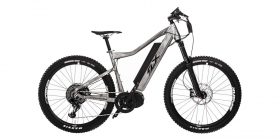
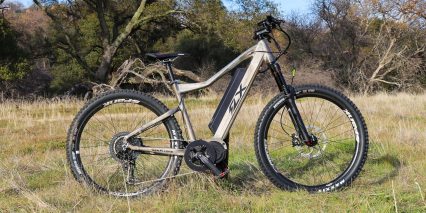
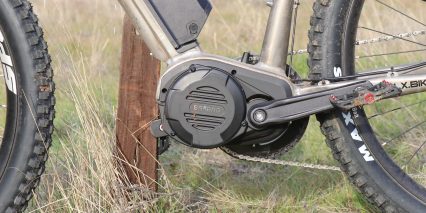
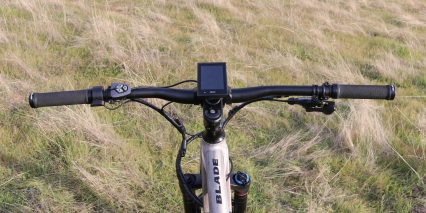
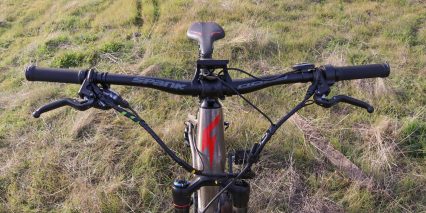

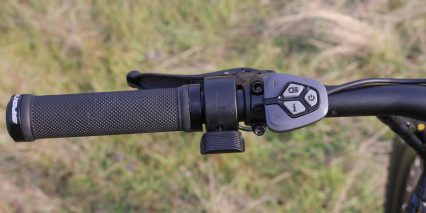
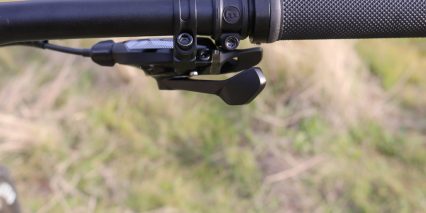
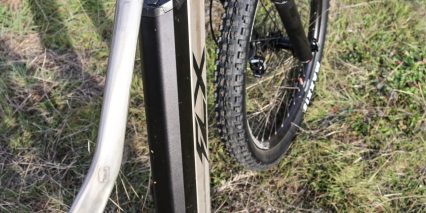

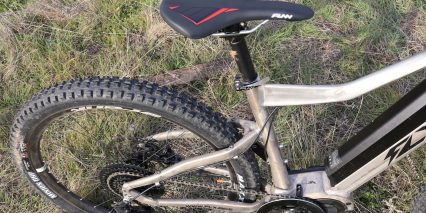
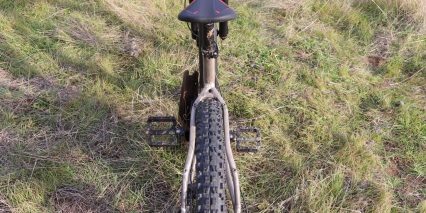
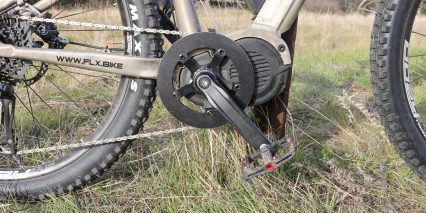
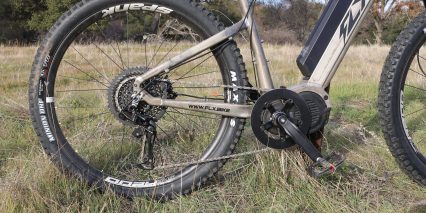
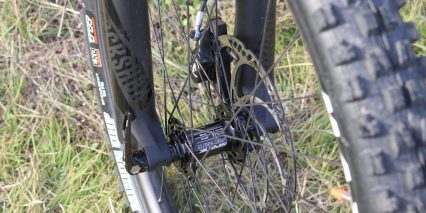

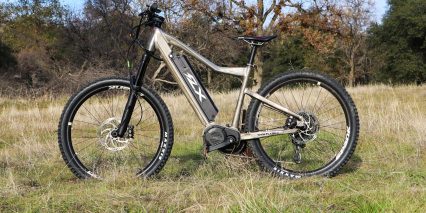
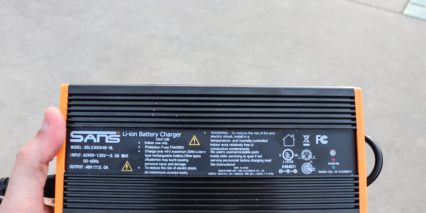

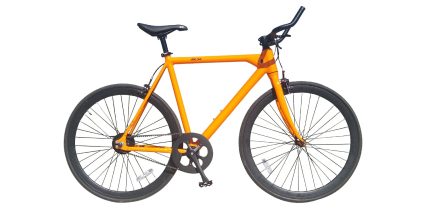
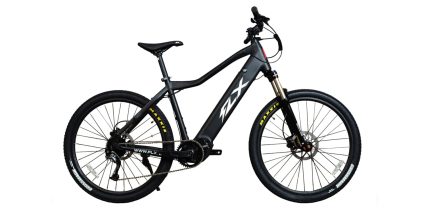
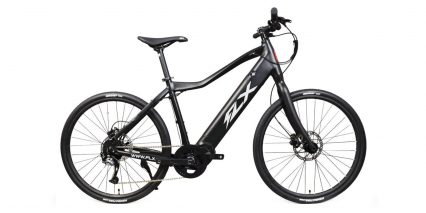
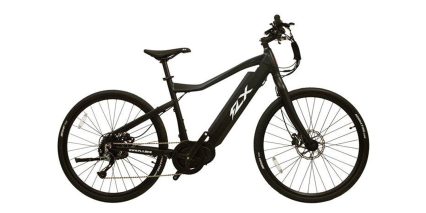
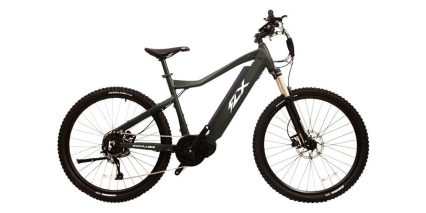

Roy Gustaveson
7 years agoYou mention in the review that because of its speed it is illegal to ride on the street. If you were to set the max speed at 20-28 mph would that make it street legal?
ReplyCourt Rye
7 years agoHi Roy! My understanding is that ebikes are rated by their motor nominal output. Anything under 750 watts could qualify as Class 1, 2, or 3 in the US and then they are sorted out by max speed and pedal assist vs. throttle so that 1 and 2 go up to 20 mph and 3 can reach ~28 with pedal assist only. I doesn’t seem like there’s a lot of enforcement going on with electric bicycles… but that doesn’t mean that a lawyer wouldn’t dig into the exact details of your bike and use that in a lawsuit if something unfortunate happened. I tend to stay on the very safe side (this is Court writing this comment) whereas Brent really likes the high speed stuff and enjoys the off-road private use. I hardly ever ride on OHV trails and very frequently commute on city streets so I would not feel comfortable buying this bike for myself. I just wouldn’t want to bend the rules and thus, would not use it very much.
ReplyGary Alexander
7 years agoWhat Court said is true. However, with the use of a $25 programming cable, anyone who is not comfortable riding this bike on public roads / bike paths as it ships, can, in 5 minutes neuter the bike cown to 750 wats, 20 mph max throttle and 28 mph max PAS. This would make it totally legal for class 3 approved paths.
Additionally you could neuter it all the way down to class II if you really wanted to ride ONLY in class II approved areas. Personally, mine is arriving tomorrow and I will ride it as delivered!
Replycourt
7 years agoCool! Do you have a link or more information on the programming cables? I haven’t ever installed one and have limited experience with ebike tuning. Thanks for sharing the tips and options for people who might not be aware. I hope yours arrives in great condition and you’re able to get out for some fun rides very soon :D
ReplyGary Alexander
7 years agoCourt,
Here is a link on where to purchase the cable https://amzn.to/2L9DtwO This cable also works for the Ultra Max 1000. Or just do a search for BBSHD programming cable. Next you need to download the software for free from Bafang for use on windows. Very easy!
For actual programming values, look for the article by Karl called programming the BBSHD. The maximum amps for 750 watts would be 15 amps. You can also set maximum speed etc. Karls article goes thru every setting choice.
David
7 years agoIt seems EBR had the pleasure of reviewing an FLX Blade that actually works properly. On paper, and in the above review, the FLX Blade seems like an amazing bike. That said, I would think twice before considering your purchase of an FLX Blade. I recently purchased a Blade with defective components including the drivetrain and possibly the motor. FLX after-purchase customer support is abysmal. There are quality control and product design issues with the Blade and the company is aware of problems they are having without offering adequate post-purchase support or remedy for the problems. There is an expectation of a certain level of quality and reliability with a bike at this price point. The battery will not stay connected during normal riding, which cuts power to the bike randomly. This can be dangerous, depending on what you’re doing when the bike spontaneously loses power. Random loss of power happened several times during my first and only day with the Blade. FLX Bike is aware of this issue. Some of the components of the touring package (fenders) are not actually made to fit the bike, and when you bring this up with the company they will tell you that maybe you can find some other fenders that fit better. The integrated lights in the touring package work well and as expected, but the fenders are a complete joke. I am still waiting for a resolution with my defective FLX Blade, but right now I have am FLX Blade in my living room that cannot be safely ridden and FLXbike thus far has yet to rectify problems with a brand new $4,000+ bike that doesn’t work. Buyer beware.
Replycourt
7 years agoOuch! Thanks for taking the time to write this, David. I’m sorry to hear that your experience with the bike and aftermarket support has been frustrating. That is a lot of money to spend for a bike that isn’t working right… and I agree with your assessment of the fenders (this is Court commenting, not Brent who did the review). I personally feel that our review was a little fluffy because Brent was newer at the time and didn’t have as much experience to provide the deeper insights. Your comment will help to educate others and I hope that FLX continues to improve their hardware quality and customer service.
ReplyAdel
6 years agoHi David, how is the bike doing this day? Is it working properly now?
Reply– Adel
Gonflyn
6 years agoHey Court, I’m considering a Blade and would like to know of any feedback on how riding the bike feels without assist.
I currently have a Smartmotion Catalyst, and one thing I really like about it is that it rides very similar to a regular bike with the assist off. I like to take 50 mile rides often and usually ride the first half without any assist for a workout, and then turn on the boost to chill out and fly home. I also like the reassurance that, if my battery were to die, pedaling home with no power wouldn’t be a huge problem.
I’d like to know how mid drives pedal without assist, and specifically something as beefy as the Blade, any comments?
ReplyCourt
6 years agoHi Gonflyn, very cool name you have! I wasn’t the person who actually reviewed the FLX Blade, that was Brent. My guess in looking at the stats and knowing how these mid-drive motors work is that the bike would be heavy but coast without any drag from the motor. The motor and battery weight are well balanced, you could lock the front suspension fork out to reduce bob, but it’s still going to be less efficient than the Smartmotion Catalyst. To be honest, I’m not sure if Smartmotion is still selling in the USA right now because of the tariffs. You might want to reach out to them beforehand because the Catalyst might not be an option.
Replygonflyn
6 years agoHey Court, thanks for the reply, great to have you guys around as the go-to site for everything Ebike! I already have had the Catalyst for a few months and like it, but was interested in the Blade because of the extra power. I know the Blade is a little heavier but wondering if in general pedaling a mid-drive takes more effort than a hub drive when riding without assist? What are your thoughts on that?
Also, FYI, according to Chris Head of Lectric Cycles, he is working on taking on distribution of Smartmotion in the U.S. himself after Lectric Cycle moved and stopped carrying SM. The company is considering possibly moving production to deal with the tariff issue, so sounds like they do want to continue to grow in the U.S. market. They have a few brand new models for 2019, so should be interesting to see how it pans out. Meanwhile, Chris is currently providing support on behalf of Smartmotion for any service or warranty issues and has been super helpful with any of my concerns.